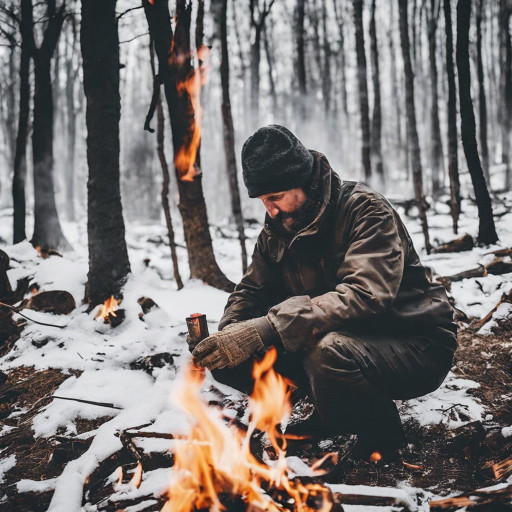Essential Fire Starting Techniques for Thriving in Extreme Cold Conditions
Successfully starting a fire in freezing temperatures is not just an advantageous skill; it is a vital necessity for survival in the unforgiving winter wilderness, marked by piercing cold and relentless winds. For the dedicated survivalist, the ability to create fire is paramount, providing essential warmth, light, and a means to cook food. However, igniting flames in icy environments brings forth distinct obstacles that require specialized techniques and strategies. This thorough guide will explore the most effective and reliable methods for successfully starting fires in cold weather conditions, arming you with indispensable knowledge and practical skills to navigate the harsh realities of winter and thrive in the wild.
Key Equipment for Fire Starting: Prepare for Cold Weather Adventures
Before venturing into the winter wilderness, it is crucial to equip yourself with the right gear and supplies that will significantly enhance your chances of survival. A well-prepared fire-starting kit can be the difference between life and death in harsh weather conditions. Your kit should include the following essential items to ensure you are ready for any situation:

a. Firestarters: Dependable tools such as waterproof matches, storm-resistant lighters, and fire-starting rods are essential for ensuring ignition, even in challenging conditions like wind and moisture. Having multiple reliable options not only boosts your confidence but also equips you to start a fire, regardless of the environmental challenges you encounter.
b. Dry Tinder: Locating dry tinder in freezing temperatures can be particularly daunting. To tackle this issue, include highly flammable materials in your kit, such as birch bark, fatwood shavings, and cotton balls saturated with petroleum jelly. These items ignite quickly and dramatically enhance your chances of successfully lighting a fire when temperatures plunge below freezing, ensuring you can keep warm.
c. Kindling: To establish a solid base for your fire, gather dry sticks, twigs, and leaves. It is crucial that these materials are entirely dry, as any moisture can impede the ignition process, leading to frustration when attempting to spark a flame. Properly prepared kindling is vital for transitioning from tinder to a more robust fire, ensuring you have a sustainable heat source.
d. Fuel: Securing dry firewood in frigid temperatures can be both challenging and time-consuming. Therefore, it is essential to have a sufficient supply of dry firewood ready in advance. This preparation allows you to maintain a steady fire for prolonged periods, which is critical for staying warm and cooking meals comfortably.
Choosing the Ideal Fire Location: Increase Efficiency and Safety
When temperatures plummet, selecting the appropriate location for your fire can offer significant advantages. Seek out sheltered spots, such as rock formations or dense shrubbery, to reduce exposure to harsh winds. By positioning your fire near a natural windbreak, you not only minimize heat loss but also improve your chances of maintaining a steady flame. Additionally, consider constructing a small wind-resistant shelter using logs or a tarp to shield the fire from precipitation and help retain warmth, significantly enhancing your overall comfort and safety while outdoors.
Layering Techniques for Effective Fire Building: Ensure Sustained Flames
Mastering the art of layering your materials is one of the most critical techniques for successfully igniting a fire in cold conditions. To build a fire that burns consistently, you must utilize three foundational layers: tinder, kindling, and fuel. Here’s a detailed breakdown of each layer and its importance:
a. Tinder: The initial layer, known as tinder, consists of materials that ignite quickly and easily. Use fine, dry substances such as grass, paper, or the aforementioned birch bark to secure a robust initial flame. It’s crucial to have an ample supply of tinder to achieve successful ignition, especially in chilly environments where starting a fire can be particularly challenging.
b. Kindling: This layer encompasses small sticks and twigs that catch fire swiftly and provide sustained heat. Gradually add kindling to your flame, ensuring there is sufficient space between pieces to promote airflow and encourage combustion. This step is essential for transitioning from small flames to a larger, more stable fire, allowing you to maintain warmth efficiently.
c. Fuel: Once a steady flame has been established, gradually introduce larger pieces of firewood. Ensure the wood is thoroughly dry, as it will burn longer and generate more heat. Increase the size of the wood pieces progressively, allowing the flames to strengthen before adding larger logs. This strategic approach to layering your fire facilitates a stable and sustainable flame, crucial for enduring cold conditions.
The layering technique creates a structured setup that allows the flames to expand and sustain effectively. Always ensure you have an adequate supply of each component readily available to facilitate a smooth transition from tinder to fuel, thereby maximizing your chances of successfully starting a fire in challenging conditions.
Boost Fire Starting Success with Proven Aids and Techniques
In extremely cold weather, leveraging additional fire-starting aids can significantly enhance your chances of successfully igniting a fire against the challenges posed by low temperatures. Here are several effective methods to consider incorporating into your fire-starting toolkit:
a. Fatwood: Often dubbed nature’s firestarter, fatwood is resin-infused pine wood that ignites easily and burns with intense heat. You can gather these naturally occurring sticks from fallen pine trees or purchase them from outdoor supply stores. Just a few pieces of fatwood can dramatically improve your chances of successfully starting a fire in particularly cold conditions, making it an invaluable addition to your kit.
b. Alcohol-Based Hand Sanitizer: Surprisingly effective, alcohol-based hand sanitizer is highly flammable and serves as an accelerant. Applying a small amount to your tinder or kindling can aid in igniting a fire quickly, even in damp conditions. This simple addition simplifies the fire-starting process, ensuring you remain warm when it matters most.
c. Char Cloth: Char cloth is specially prepared fabric that ignites easily from sparks, making it an invaluable tool for starting fires using flint and steel or a lighter in challenging situations. Its lightweight and portable nature makes it an ideal addition to your fire-starting kit, ensuring you are always prepared to face the elements.
Incorporating these fire-starting aids into your cold-weather toolkit can significantly enhance your success rate when confronting particularly challenging conditions, enabling you to adapt effectively to your environment and maintain your safety.
Explore Innovative Fire Techniques Tailored for Cold Weather Conditions
As a committed survivalist, continually refining your skills is essential for achieving success in the wild. Here are two fire techniques that stand out for their effectiveness in cold weather conditions:
a. Swedish Torch: Also referred to as a Canadian Candle or Finnish Fire Log, the Swedish Torch is an extraordinarily effective fire-starting method. This technique generates a stable and long-lasting flame, making it ideal for combating winter chills. To create a Swedish Torch, locate a log approximately knee-height and cut several vertical slits along its length. Insert tinder into the slits and ignite it. The log will act as a consistent fuel source, allowing the flame to endure for an extended period, ensuring warmth and safety in the cold.
b. Dakota Fire Hole: When faced with strong winds, the Dakota Fire Hole method proves exceptionally effective. This technique entails digging a hole and tunneling horizontally underground to create an airflow vent. This design harnesses wind to enhance airflow, resulting in a more efficient fire that is less likely to be disrupted by gusts. Moreover, the Dakota Fire Hole method effectively reduces visible smoke while conserving fuel, making it an excellent choice for discreet fire building while minimizing your environmental impact.
Regardless of which method you choose, always prioritize safety and responsible fire management to minimize risks and ensure a successful fire-starting experience in the wilderness.
Successfully igniting a fire in cold weather requires meticulous planning and execution. By following these essential steps—preparing a reliable fire-starting kit, selecting an appropriate location, mastering layering techniques, utilizing fire-starting aids, and employing specific fire strategies—you will substantially increase your chances of success. Remember, consistent practice is key, so continually train to refine your skills and bolster your confidence. With these indispensable tactics for igniting fires in freezing conditions at your disposal, you'll be well-equipped to face even the harshest winters nature has to offer. Stay warm, prioritize your safety, and keep the flames of survival alive!
The post Fire Starting Methods for Survivalists in Cold Weather appeared first on Survival Bite.
The Article Fire Starting Techniques for Cold Weather Survival Was Found On https://limitsofstrategy.com
The Article Cold Weather Survival: Essential Fire Starting Techniques First Appeared ON
: https://ad4sc.com


I really appreciate this guide on fire starting in extreme cold. It’s such an underrated skill, and honestly, I’ve had my fair share of struggles with it myself. I remember one winter camping trip where I thought I was well-prepared but ended up battling frozen kindling and damp wood for hours. It’s incredible how the smallest things, like moisture levels or having the right tinder, can make such a huge difference.
Your blog post underscores a crucial survival skill that often goes overlooked in winter preparedness discussions. The ability to start a fire in extreme cold not only serves as a physical necessity but also has significant psychological implications. As someone who has trekked in frigid conditions, I can attest to the comforting effect of a fire in the wilderness—a flickering flame not only offers warmth but also creates a sense of security and community among fellow adventurers.